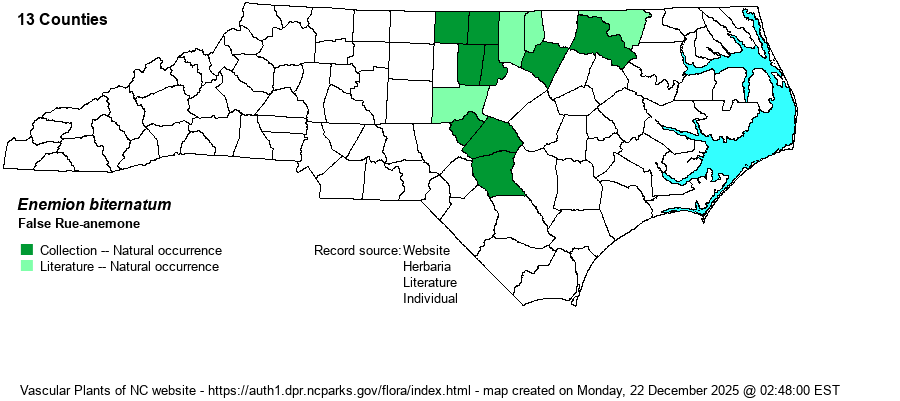| Author | Rafinesque | |
| Distribution | Limited to the lower Piedmont and upper Coastal Plain; essentially all records are in the floodplains or adjacent slopes of brownwater rivers -- Roanoke/Dan, Tar, Deep, and Cape Fear/Haw are the main rivers, with the Neuse less so.
This species is found primarily in the Midwestern states, from MI and MN south to AL and OK. However, there are disjunct populations east of the Appalachians -- mainly in southern VA and central NC, but sparingly elsewhere. | |
| Abundance | On the landscape, this species is generally rare, even in proper habitat. Nonetheless, populations may be locally common along the Deep, Cape Fear, and Haw rivers from Chatham to Cumberland counties; and also locally common along the upper Roanoke River in Halifax and Northampton counties. Elsewhere, mainly rare to locally uncommon in the northeastern Piedmont. This is a State Special Concern species, mainly because the eastern disjunct population is limited mostly to NC. However, NCNHP has 34 records, of which about 28 are current, and many are fairly large; as a result, in 2024 the NCNHP moved the State Rank from S2 to now S2S3. | |
| Habitat | This is a requisite mafic species, found only over circumneutral soil -- either over rocks such as amphibolite or gabbro, or just as often on extremely rich sediments of brownwater alluvium deposited on levees and other floodplains. In Lee County it is abundant by the Deep River where it crosses the Triassic Basin. It grows in both Basic Mesic Forests on slopes and on rich Natural Levee forests. |
| Phenology | Blooms in March and April, and fruits in May. | |
| Identification | This is a small and delicate spring-blooming herb that almost always grows in extensive patches or colonies. It grows only to about 6-9 inches tall on average, with both basal and cauline (stem) leaves. The basal leaves have long petioles to several inches, with doubly ternate leaves, that is, up to 6-9 leaflets, each only about 2/3-inch long and typically glove-shaped with a large middle lobe and two smaller side lobes. The flowering stem also has divided leaves, some once-pinnate and some twice-pinnate, and each set of 3 leaflets is similar to the basal ones -- small and glove shaped, with the middle lobe the largest. (See photos online for a better picture of the leaves.) There are typically a few flowers at the tip of the stem, each consisting of 5 obovate and rounded white sepals that form a flower that is about 2/3-inch across. As mentioned above, this species habitually grows in sizable colonies; if you can catch the flowering period correctly, the herb layer can be snow white with the flowers. Be aware that there are several other low-growing spring wildflowers with white flowers -- Virginia Spring-beauty (Claytonia virginica), Lanceleaf Anemone (Anemone lancifolia), and especially Rue Anemone (Thalictrum thalictroides). The first has narrow single leaves, the second has strongly cut and serrated leaves and leaflets, and the third has mostly 6-8 white to light pinkish sepals. Be especially careful with the last species, as more than once a report of Enemion has turned out to be the common Thalictrum. Also note that Enemion is a spring ephemeral species, and not only are the fruit finished by May, but the entire plant withers back to the ground during that month, and thus after about the middle of May there is no sign of the species on the ground surface until late in the year or in late winter, when basal leaves can appear (even through the winter).
| |
| Taxonomic Comments | This species was formerly named as Isopyrum biternatum (as in RAB 1968).
| |
| Other Common Name(s) | Isopyrum, Eastern Isopyrum, Eastern False Rue-anemone. Note that Thalictrum thalictroides is usually named simply as Rue Anemone. However, it is in a different genus -- where nearly all other species are named as "xxxxx Meadow-rue" -- and thus there seems to be little confusion between these two species -- Enemion and Thalictrum thalictroides -- by most people, in the field or in references. | |
| State Rank | S2S3 | |
| Global Rank | G5 | |
| State Status | SC-V | |
| US Status | | |
| USACE-agcp | FACW link |
| USACE-emp | FACU link |

